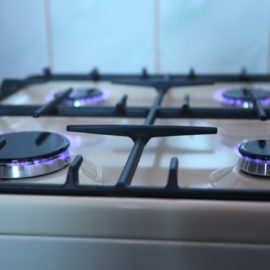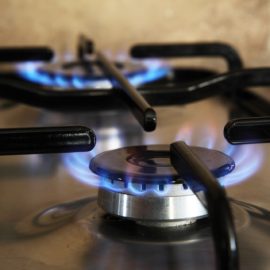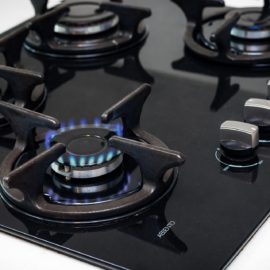
The flame looks nice but it is polluting the air in your house. Here are some ideas on how to make them safer.
Mounting evidence of the potential health risks of gas stoves, including a link to childhood asthma, ignited a debate in Washington this week, after a commissioner of the United States Consumer Product Safety Commission suggested that his agency might move to regulate these kitchen appliances. Responding to the firestorm, Alexander Hoehn-Saric, the agency’s chairman, issued a statement on Wednesday saying, “Research indicates that emissions from gas stoves can be hazardous, and the C.P.S.C. is looking for ways to reduce related indoor air quality hazards. But to be clear, I am not looking to ban gas stoves and the C.P.S.C. has no proceeding to do so.” “No one should freak out about this news,” said Dr. Aaron Bernstein, the interim director of the Center for Climate, Health and the Global Environment at Harvard T.H. Chan School of Public Health, who has studied gas stoves and pollutants. But Dr. Bernstein and other researchers say that it’s important to understand, and mitigate, the dangers of gas stoves, which are used in about 40 million homes nationwide.
nytimes.com
Stoves do present hazards and since they are in homes it effects the residents.
For the last fifty years or so, researchers have demonstrated that exposure to gas stoves can be harmful to humans, said Brady Seals, a manager at the environmental think tank R.M.I. When you use a gas stove, it emits poisonous gases called nitrogen oxides, including nitrogen dioxide, a respiratory irritant thought to trigger asthma (cars, boats and other machines also release these gases). A study published last year found that families who use gas stoves in homes with poor ventilation, or without range hoods, can blow past the national standard for safe hourly outdoor exposure to nitrogen oxides within just a few minutes; there are no agreed upon standards for nitrogen oxides in indoor air. Rates of nitrogen oxide emission levels were in direct proportion to the amount of gas the stove was burning, said Eric Lebel, a senior scientist at P.S.E. Healthy Energy, a nonprofit science and policy research institute focusing on energy and the environment, and the lead author on the study. Ms. Seals co-authored a paper published in December that found that gas-burning stoves may be linked to nearly 13 percent of childhood cases of asthma in the U.S. Past research shows that gas stoves led to more exacerbated asthma symptoms as well, she said.
The effect is worse on children and older adults.
There’s more data on how gas stoves affect children than there is on how they affect adults, but Ms. Seals said findings suggest that adults with asthma may also be susceptible to worsened symptoms. Children and adults with chronic respiratory conditions are most at risk of negative health effects linked to gas stoves, added Dr. William Checkley, an associate professor of medicine at Johns Hopkins Medicine. In addition to asthma, there are other health dangers associated with gas stoves: Researchers who collected 234 samples of unburned natural gas from 69 homes around Boston found 21 toxic pollutants in the gas, including benzene, a known carcinogen, said Dr. Bernstein, who participated in the study. Experts say the average person should use caution with gas stoves, but these findings don’t necessarily mean you will get sick. “Just because you have a gas stove doesn’t mean you’re guaranteed to develop asthma or cancer,” Dr. Lebel said. Some people may consider switching from a gas stove to, say, an induction range when they are in the market for a new appliance. For those with a gas stove currently, there are a few simple ways to mitigate potential health risks.
Lower your risk with these few suggestions.
Ventilate, ventilate, ventilate. Open the windows, crack open a door, put on a fan — try to ventilate your kitchen as much as possible when you’re using your stove. “Fresh air can really dilute the concentration” of air pollutants, Dr. Bernstein said.
Use the exhaust hood every time you use your stove. Even if you’re just boiling water, turn on the exhaust hood, Dr. Lebel said. The fan will be most effective if it blows the air outside, but you can still use it even if it doesn’t. If your exhaust hood doesn’t vent the air outside, or if you’re not sure, open a window near where you’re cooking and consider putting a fan in the window, he suggested.
Try to use the stove less often.
Exposure can have a direct impact: research shows that when a stove is used to cook dinner, more children tend to use their inhalers that night, Ms. Seals said. Instead of using your stove as the default for all cooking and food-heating, think about using an alternative like a microwave or toaster oven. Or consider getting an electric kettle to boil water, Ms. Seals said. You could also plug in a portable induction burner, she suggested.
Consider buying an air purifier. An air purifier with a HEPA filter can help reduce the level of nitrogen oxides concentrating in the home, said Dr. Ravi Kalhan, a pulmonary medicine specialist at Northwestern University Feinberg School of Medicine. If you’re able to purchase one, place it in or near your kitchen, he said. (Wirecutter has guidance for selecting an air purifier.)
Use these to reduce risk.
Despite the recent news around gas stoves, it’s important to remember that there are concrete steps you can take to reduce their risks, Ms. Seals said. “I think it’s a concern, but it’s a concern that can be mitigated. It’s a concern we have solutions for.”
The first three are easy and I do use our toaster oven a lot. Turning on the fan I do when cooking food that smells but the low speed when using the cook top is a good idea.



